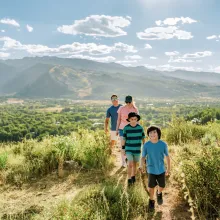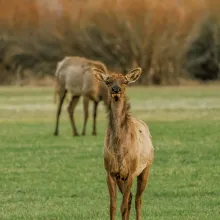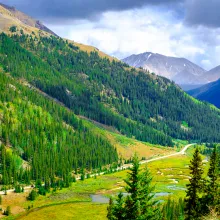Aspen is defined by its natural beauty and incredible access to the outdoors. While humans enjoy exploring the area, Aspen is home to a range of residents. Whether you’re hiking through the mountains or taking a stroll through town, it’s not uncommon to encounter wildlife, especially during the summer months. Before your next outing, be sure to remember these safety tips that will keep both you and wildlife safe.

Smaller furry mammals - chipmunks, squirrels, raccoons, fox, and deer – are just some of the more well known wildlife that reside in Aspen, and will most likely make their way closer to town. Although these little creatures are adorable, it’s crucial not to make them feel threatened by touching or chasing them, as they are wild and will defend themselves.
Most of the time, Colorado’s large mammals like elk, bears, or cats, are tucked away in the mountains, occasionally coming closer to town. Elk are beautiful animals providing quite the sight to see. The spring and fall are seasons for mating and calving, and therefore, it’s vital that spectators take precautions, as Elk can be more aggressive during these times. If the larger creatures like bears or cats get too close to your home, don’t approach or corner them, and be sure to call Aspen Police Department if you feel they are a threat.
There have been incidents reported in past news involving humans and bears in Aspen. Due to these incidents, ACRA wants to remind locals and visitors about proper human behavior during bear season. Wildlife officials have stated that many incidents have occurred from bears looking for "easy meals in populated areas." Learning about how to react when you encounter a bear, or other wildlife, is important for your safety and the animals'.
Bears:
- Do not approach bears
- Stand still, talk in a normal voice, and stay calm; let the bear identify you
- If the bear doesn't leave, wave your arms slowly and talk calmly. Slowly back away, without turning your back, until the bear is out of sight.
- Don’t run or climb a tree.
- Do not feed
- Double bag food, and never leave trash or leftovers behind.
- Don't leave food, trash, or anything that smells in your car
- Keep all bear-accessible windows and doors closed and locked, including home, garage and vehicle doors
- To deter bears from coming near your home, securely store garbage, do not leave trash out overnight, use wildlife-resistant containers, regularly clean containers, remove bird-feeders from April-November, and do not feed pets outside or leave the food outside.
- Mothers with cubs rarely attack humans, but it's important to never get between them. Mothers can perform a bluff rush to scare threats. If you find yourself near, or between a mother and her cubs, slowly back away and keep your distance.
- For more bear safety tips, visit Colorado Parks & Wildlife.
Mountain Lions:
- Act like a predator – maintain eye contact, don’t run, don’t bend over, wave your raised arms
- Make yourself appear larger
- Make noise
- Fight back
- Moose view dogs as coyotes, which are a threat, and they will attack, which is why you should always keep your dog on a leash in common moose territory (which in 2019 does include Smuggler Mountain Road)
- Never walk between a moose and a calf.
- Never approach a moose, walk the other direction and take the long way around.
- A moose may display warning signs before they become aggressive such as: raising the hair on their neck, laid back ears and licking of the snout. (More information from CPW here)
- If a moose feels threatened they will attack, they will often bluff charge first, but if they do make contact they will kick with their hooves and trample you.
- If a moose displays aggressive behavior or begins to charge, run as fast as you can and try to put a large object, such as a boulder, car, or tree, between you.
Wolves:
- Never approach wolves
- Make eye contact with the wolf and speak firmly; the wolf will know it has been spotted
- Keep dogs away- dogs can aggravate wolves.
- If there is shelter or a vehicle nearby, face the wolf, stand tall, and slowly back away. Do not run.
- If you can't retreat, stay where you are, and make yourself appear larger: stand on a rock, wave your arms, and flare your jacket while continuing to face the wolf. If possible, group up with other people or place a barrier (like a bike) between you and the wolf.
- If it continues to approach or behave aggressively (eyes locked and ears forward or backwards), yell, clap, wave a walking stick in front of you, and make noise.
- With continued aggression (growling, baring teeth, lowered ears), use bear spray or prepare to fight back (its underbelly and face are most sensitive).
- Never feed wolves- this leads to more aggressive behavior towards humans.
- Do not leave small children unattended.
- For more information visit the National Park Service or Colorado Parks and Wildlife.
Other General Safety Tips For All Wildlife:
- Do not touch or approach wildlife.
- Do not chase wildlife. Keep pets on leashes.
- Maintain a safe distance. Use binoculars or a zoom lens to get a better look.
- Posting photos of the wildlife to your social media account only draws larger crowds, which can agitate animals and create a dangerous situation.
- Follow the rule of thumb: if you can cover the entire wild animal with your thumb you're at a safe distance. This distance is usually 100 yards from wildlife. Use binoculars or a camera with zoom to view animals from a safe distance.
- Be alert – if an animal appears startled, changes it’s behavior, or walks away, you are too close.
- Never feed the wildlife; keep animals wild and healthy.
















